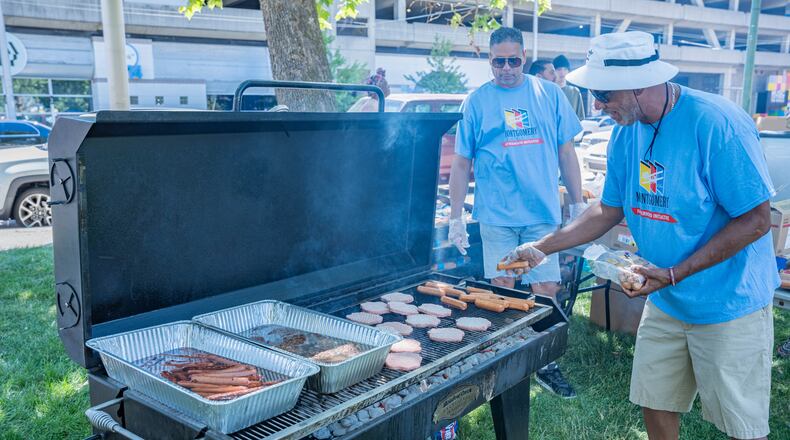- Keep cold food cold. Place cold food in a cooler with ice or frozen gel packs. Cold food should be stored at 40 degrees or below to prevent bacteria growth. Meat, poultry, and seafood may be packed while still frozen so that they stay colder longer.
- Organize cooler contents. Consider packing beverages in one cooler and perishable foods in another. That way, as picnickers open and reopen the beverage cooler to replenish their drinks, the perishable foods won’t be exposed to warm outdoor air temperatures.
- Keep coolers closed: Once at the picnic site, limit the number of times the cooler is opened as much as you can. This helps to keep the contents cold longer.
- Don’t cross-contaminate. Be sure to keep raw meat, poultry, and seafood securely wrapped. This keeps their juices from contaminating prepared/cooked foods or foods that will be eaten raw, such as fruits and vegetables.
- Clean your produce. Rinse fresh fruits and vegetables under running tap water before packing them in the cooler — including those with skins and rinds that are not eaten. Rub firm-skinned fruits and vegetables under running tap water or scrub with a clean vegetable brush while rinsing with running tap water. Dry fruits and vegetables with a clean cloth towel or paper towel. Packaged fruits and vegetables that are labeled “ready to eat,” “washed,” or “triple washed” need not be washed.
Food safety begins with proper hand cleaning — including in outdoor settings. Before you begin setting out your picnic feast, make sure hands and surfaces are clean.
- Outdoor hand cleaning: If you don’t have access to running water, use a water jug, some soap, and paper towels. Or consider using moist disposable towelettes for cleaning your hands.
- Utensils and serving dishes: Take care to keep all utensils and platters clean when preparing food.
Grilling and picnicking often go together. And just as with cooking indoors, there are important guidelines that should be followed to ensure that your grilled food reaches the table safely.
- Marinate safely. Marinate foods in the refrigerator — never on the kitchen counter or outdoors. In addition, if you plan to use some of the marinade as a sauce on the cooked food, reserve a portion separately before adding the raw meat, poultry, or seafood. Don’t reuse marinade.
- Cook immediately after “partial cooking.” Partial cooking before grilling is only safe when the partially cooked food can go on the hot grill immediately, for example at a home with a grill on the patio or deck.
- Cook food thoroughly. When it’s time to cook the food, have your food thermometer ready. Always use it to be sure your food is cooked thoroughly.
- Keep “ready” food hot. Grilled food can be kept hot until served by moving it to the side of the grill rack, just away from the coals. This keeps it hot but prevents overcooking.
- Don’t reuse platters or utensils. Using the same platter or utensils that previously held raw meat, poultry, or seafood allows bacteria from the raw food’s juices to spread to the cooked food. Instead, have a clean platter and utensils ready at grill-side to serve your food.
Recipe: Grilled Tilapia with Mango
Ingredients:
4 tilapia fillets (6oz. each)
1 tbsp. olive oil
½ tsp. salt
½ tsp. dill weed
¼ tsp. pepper
1 tbsp. grated Parmesan cheese
1 medium lemon, sliced
1 medium mango, peeled and thinly sliced
Directions:
- Brush fillets with oil; sprinkle with salt, dill and pepper
- Grill tilapia, covered, on a lightly oiled rack over medium heat for 5-minutes.
- Turn tilapia; top with Parmesan cheesed, slice lemon and mango. Grill until the fish flakes easily with a fork, 4-6 minutes longer.
Tip: Add mango to your regular fruit rotation to boost your intake of important nutrients like vitamin C and A, and potassium.
Red, White & Blue Summer Salad
Ingredients:
2/3 cup extra virgin oil
½ cup julienned fresh basil
1/3 cup white balsamic vinegar
¼ cup julienned fresh mint leaves
2 garlic cloves, minced
2 tsp. Dijon mustard
1 tsp. sea salt
1 tsp. sugar
1 tsp. pepper
2 cups cherry tomatoes
8 cups fresh arugula
1 carton (8 oz.) fresh mozzarella cheese pearls, drained
2 medium peaches
2 cups fresh blueberries
6 oz. thinly sliced prosciutto, julienned
Directions:
- In a bowl, whisk the first 9 ingredients. Add tomatoes; let stand while preparing salad.
- In another bowl, combine arugula mozzarella, peach slices, blueberries, and prosciutto.
- Pour tomato mixture over top; toss to coat. Garnish with additional mint leaves. Serve immediately.
MORE DETAILS
Interested in free nutrition education classes with Ohio State University Extension’s Expanded Food and Nutrition Education Program? Contact Nancy Lyons at lyons.489@osu.edu or 937-205-5250.
About the Author
